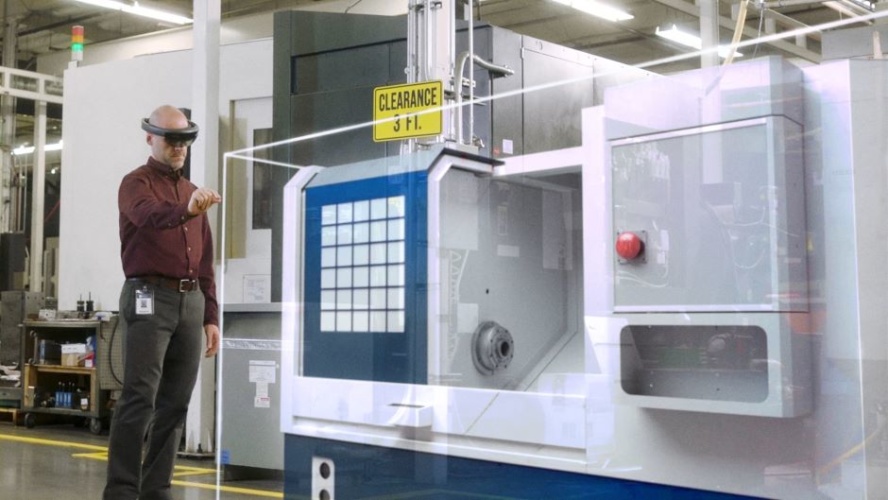
The term ‘Metaverse’ is likely to be heard more often in the world of business and enterprise - including manufacturing - in the future, even though for the moment at least it is imprecise and “over-hyped”. That is the estimate of Amy Peck, US-based consultant and strategist who runs her own company EndeavorVR from headquarters in San Francisco, seeking to convince the business world of the tangible benefits they can gain from technologies that create ‘virtual’ environments.
There are a number of them. They include ‘augmented’ reality (AR) in which a user dons a headset or special glasses that can project explanatory text or graphical information on to a real world object in front of them, and also complete ‘virtual’ reality (VR) in which a user becomes totally immersed in a computer-generated world. They are being joined by ‘mixed’ reality (MR) in which, Peck explains, the real and the virtual interact with each other dynamically in a totally integrated manner so that, as she explains, “a virtual ball that rolls off a real table will bounce.”
Opinion: XR collaboration is key to factory floor transformation
Expert Q&A: Reality check – trends in XR
That term ‘Metaverse’ effectively aggregates them – as does XR for ‘extended’ reality - and if Peck is cautious in her own use of the term, she is in no doubt that the technologies involved do have the potential to “improve human life”. Indeed Peck says that this has been borne out in the most practical and immediate manner in the way the pharmaceutical industry has been able to develop and manufacture vaccines in response to the Covid pandemic.
“The pharmaceutical industry been major user over last couple of years as they looked to build new lines or retrofit older ones to cope with vaccines for the pandemic,” Peck says. “The challenges were training people and getting approval for manufacturing processes in parallel with actually building them.” But, she says, this was consistently achieved through the exploitation of “3D assets”, a statement she makes with complete confidence. “I worked with one such company and know that there were several others,” she confirms.

The underlying message about the utility of virtual technologies in the enterprise world is one that Peck has been promoting since she founded her company in 2015. But she says the revelatory moment came a couple of years earlier when she was working for a company with a hand-tracking product aimed at a consumer audience. Some of the company’s engineers, she recalls, combined its hardware with an early version of the Oculus VR headset – the integrating mechanism being some duct tape – so that she was able to see her own hands in a virtual environment and the experience proved revelatory. “We have a joke in the industry that we can all remember our first time,” she says.
Nevertheless, Peck says that as someone who regards herself as a business strategist, she immediately began to think in terms of how virtual technologies could be applied in work environments and so the transition to her present role followed almost inevitably. Even now, though, she says that the adoption of virtual technologies by companies is still highly dependent on particular corporate culture. Those with an “aptitude for innovation” are, she says, most likely to be the ones who turn curiosity into active investigation and implementation.
Peck says she is currently working with a US manufacturer of specialist high-performance cars that is using AR to provide guidance to the shopfloor assembly workers. Client confidentiality stops her from identifying them but she is emphatic that they are reaping real benefits.
“It is a hand-built car,” she explains. “3D assets are used for training but are then used again on the line to support assembly with relevant instructions are overlaid on equipment.”
As Peck further explains, that initial implementation need only be the basis for much more intensive use of the technology. “You could have remote support for technicians with advice and support annotated on top of equipment in real time,” she says. “You could also record it for future use so you could have an endless cycle of functional improvement.”
Normally, Peck continues, practical implementations of virtual technologies “start with training because that area has strongest return-on-investment.” In this particular case, though, she says that the initial implementation area was in design “because the tech evangelist in that company worked in design.”
Peck’s use of the word ‘evangelist’ does perhaps indicate that though both the technologies and the benefits they can bring are real and not virtual, there is still a need for their active proselytisation. When asked if people who she thinks should be using them still, on occasion, exhibit extreme scepticism her answer is unambiguous: “Absolutely all of the time.”

That is why her own personal schedule is not just one of consultancy in support of real implementations but of advocacy and underpinning standards development. In the former context late November, 2021 found her in a panel discussion at the Global Manufacturing and Industrialisation Summit (GMIS) in Dubai, for instance, while early December found her helping to judge a defence industry ‘hackathon’ back in the US. In the latter she is a member of the XR Special Interest Group of the US engineering institution the IEEE where the focus, she says, is on “education and training”.
There is perhaps, as Peck acknowledges, a double edge to the fact that in the popular mind virtual technologies are strongly associated with leisure pursuits, though as she also points out “the military has been using VR for decades.” At one level this can act as a disincentive for business people, whether in manufacturing or elsewhere, to explore what the technology can bring while at the other it can act as a way of enthusing people in their jobs. “People react that to that perception of ‘gameification’ in different ways,” she says. “Sometimes they say ‘great, that will keep their employees’ attention. Sometimes they just say they don’t want employees playing games all day.”
But for Peck that melding of the recreational and the practical is highly significant. “Companies need to think about the future, not just in terms of improving their processes but as a digital transformation cycle that has to be about how they do everything, which means their products, services and the nature of their workforce as well,” she states.
Nor is there any time to waste. “Innovation no longer happens in decades long cycles,” Peck observes. “We don’t have that luxury.” Moreover there are already practical devices on the market to support appropriate strategies. Peck cites Microsoft’s Hololens 2 headset and the MagicLeap 1 goggles as examples. “There is also a company called Muse that measures brainwaves to enable the delivery of training based on individual learner characteristics.”
Those companies that recognise the potential of these technologies to support innovation and change will be the ones that benefit. They will do so, Peck believes, both in immediately quantifiable terms and in the more intangible but ultimately more valuable area of attracting new talent.
“Companies that do this will not just gain significantly in process, output, time to resolution, they will also attract the workforce of the future,” she states. “It is going to be impossible to attract young people to companies using what they will perceive as archaic systems.










Water Sector Talent Exodus Could Cripple The Sector
Well let´s do a little experiment. My last (10.4.25) half-yearly water/waste water bill from Severn Trent was £98.29. How much does not-for-profit Dŵr...